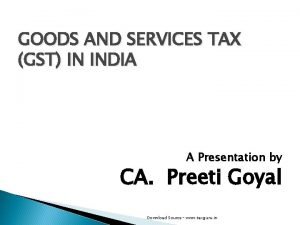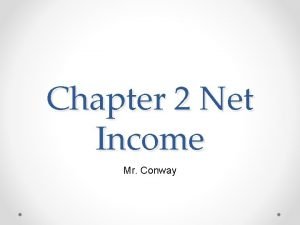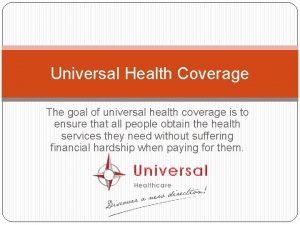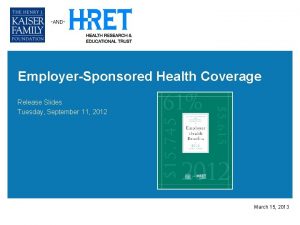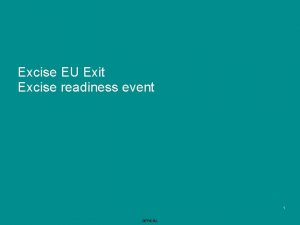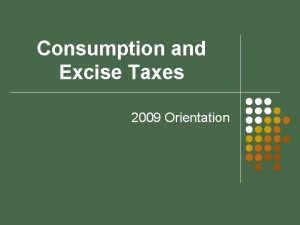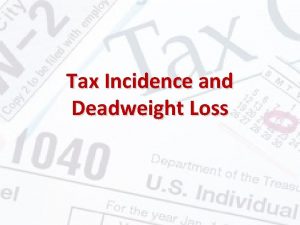The Excise Tax on HighCost EmployerSponsored Health Coverage








- Slides: 8

The Excise Tax on High-Cost Employer-Sponsored Health Coverage: Background and Economic Analysis Written By: Sean Lowry Published Online By: Congressional Research Service Published Date: 8/20/2015 Presented By: Stephen Woods

The Congressional Research Service Source: https: //www. fas. org/sgp/crs/misc/R 44160. pdf • “Since the 1920 s, Employer-Sponsored Insurance (ESI) benefits have been excluded from federal income tax. ” • “As of 2012, 65. 8% of the non-elderly population (175. 4 million people) were covered by private health insurance. Of that total, 88. 9% (156. 0 million people) were covered by an employersponsored plan. ” • “…[E]mployer-sponsored plans provide the largest single source of health coverage for the nonelderly population in the United States. ” • “…[T]he exclusion has become the largest single tax expenditure in the Internal Revenue Code. For FY 2015, the Joint Committee on Taxation (JCT) estimates that the ESI tax exclusion is the single largest federal tax expenditure—$150. 6 billion. ” • “Healthcare spending in the U. S. reached $3. 8 trillion in 2014, up from $2. 9 trillion the year before, and the government has projected such spending will surpass $5 trillion in 2022. ” Source: http: //www. rwjf. org/en/library/research/2013/01/doing-better-by-doing-less--approaches-to-tackle-overuse-of-serv. html

The Cadillac Tax – A Description • “A 40% tax on the value of applicable employer-sponsored coverage above a specified dollar threshold, also referred to as the excess benefit, beginning in 2018” • Applicable employer-sponsored coverage includes: v premiums for accident or health coverage paid by the employer or employees and v contributions to tax-advantaged accounts: flexible spending accounts (FSAs) and health savings accounts (HSAs) • Also Included are plans by public employers and health benefits of public employees (school districts, cities, states, and other public institutions) • The tax does NOT apply to coverage such as long-term care insurance, stand-alone dental and vision insurance, liability insurance, and accident and disability benefits • Employers will be responsible for calculating the tax for each employee, as well as the share attributable to each coverage provider • The tax is levied on coverage providers, i. e. , the insurer or the employer • In 2018 when the tax is first implemented, the threshold for single coverage will be $10, 200; for non-single coverage it will be $27, 500. In 2019, the thresholds will be indexed to the annual change in inflation (the Consumer Price Index for All Urban Consumers (CPI-U)) plus one percentage point. For 2020 and beyond, thresholds will be adjusted using annual changes in the CPI-U.

Purpose of the Cadillac Tax • To raise revenue to offset the cost of other ACA provisions (e. g. , the financial subsidies available through the health insurance exchanges). • To reduce the growth of national health care costs • To target higher-cost “Cadillac” health plans (which are characterized as having more generous coverage or lower cost-sharing requirements than average health plans) • To counteract the income tax exclusion for employer-sponsored insurance’s (ESI) incentives

Correction for Moral Hazard in the Health Care Sector The Cadillac Tax 1. Supply: Insurer S+t Cost ($) . 2. Demand: Employer 3. Cadillac Tax is an ad Valorem tax – a percentage of the value of the health plan B P 2 Tax amount paid by Employer P 1 t Tax amount paid by Insurer P 2 -t . S A D 4. The Cadillac tax is 40% of the amount above threshold ($27, 500 for non-single coverage (e. g. , family) and $10, 200 for single health coverage. 0 X* X 1 Cadillac Plans

Estimated Revenue and Health Cost Savings from the Cadillac Tax • “Tax exemptions for health spending cost the federal government $300 billion a year, nearly as much as the federal government spends on Medicaid. The Cadillac tax would effectively shrink those income and payroll tax breaks…. ” • “According to an August report [2015] from the Congressional Research Service, the tax can be expected to result in between $40 billion and $60 billion less in health care spending per year by 2024. ” • “The Cadillac Tax is estimated to raise $3 billion in 2018. ” • “In March 2015, CBO (Congressional Budget Office) and Joint Committee on Taxation (JCT) significantly reduced their most recent estimates of the Cadillac tax to indicate that the tax will raise $87 billion over the first eight years of implementation (FY 2018 to FY 2025). ” • “CBO and JCT estimated in March 2015 that two other provisions in ACA, the employer penalty and the individual mandate, will raise $145 billion and $34 billion, respectively, over the same eight-year period (FY 2018 to FY 2025). ”

Real Life Example: Greater Santa Cruz Federation of Teachers (20% of the Health Cost Reduction Went To Teacher Salaries) Health plan changes Family annual premium New Health Plan Old Health Plan $ 24, 516 33, 316 50% 30% $1, 021 $337 Office visit co-pay $30 $25 Hospital stay co-pay 20% $500/visit $3, 000 $49, 397 $41, 166 Paid by employee Payment per month Out of pocket maximum Starting teacher pay Sources: Molly Parks, Santa Cruz City Schools, Barry Kirschen, Greater Santa Cruz Federation of Teachers http: //www. santacruzsentinel. com/health/20151010/cadillac-tax-exit-strategy-in-santa-cruz

Links to Sources • The Cadillac Tax: Why Economists, but Few Others, Love It: http: //www. nytimes. com/2015/10/06/upshot/the-cadillac-tax-loved-by-economists-and-few-others. html? ref=topics • The Congressional Research Service Report: https: //www. fas. org/sgp/crs/misc/R 44160. pdf • The Robert Wood Foundation – The 2013 Report: http: //www. rwjf. org/en/library/research/2013/01/doing-better-by-doing-less--approaches-to-tackle-overuse-of-serv. html • What Is The Cadillac Tax? A Simple Explainer On Health Insurance Levy And Why People Are For Or Against It: • http: //www. ibtimes. com/what-cadillac-tax-simple-explainer-health-insurance-levy-why-people-are-or-against-it-2133304 • CRS Report R 44147: Excise Tax on High-Cost Employer-Sponsored Health Coverage: In Brief, by Annie L. Mach (supplemental report) https: //www. fas. org/sgp/crs/misc/R 44147. pdf • For a list of health benefits that could be subject to the Cadillac Tax, see IRS, Notice 2015 -16, February 23, 2015, at http: //www. irs. gov/pub/irs-drops/n-15 -16. pdf • Employee Benefit Research Institute (EBRI), Sources of Health Insurance and Characteristics of the Uninsured: Analysis of the March 2013 Current Population Survey, EBRI Issue Brief #390, September 2013, at http: //www. ebri. org/publications/ib/index. cfm? fa=ib. Disp&content_id=5272 • Joint Committee on Taxation (JCT), Estimates of Federal Tax Expenditures for Fiscal Years 2014 -2018, JCX-97 -14, August 5, 2014, p. 31, at https: //www. jct. gov/publications. html? func=startdown&id=4663




